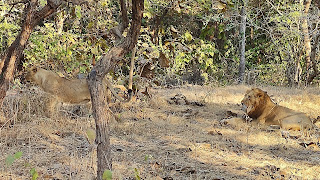In the end, they were proved right. Despite taking a slightly longer route via Amreli, and an auto driver assuring us that we would be hitting a 100 kph in a short while, we made excruciating progress, admiring huge swathes under disciplined cultivation, mostly cotton. We finally completed about 185 km in 5 and half hours, all the while alerts flashing of worn out front brake pads.
Rajiv, who was behind the wheel this day, parked at the Gir National Park office premise to enquire what further needed to be done to complete the 3 pm safari booking he had done online. We were asked to come back at 2.30 pm. Hence, it was to be lunch at Hotel Rajwada. The waiter suggested the unlimited Kathiawadi Thali, which included three types of pickles, sambharo (akin to khimchi), gur, three sabjis, dal, rice, phulka and bajra rotlas. As if not satisfied by this fare we decided to try out Kesar mango pulp! Both of us did little justice to the healthy food, much less Rajiv. However, after confirming that the pulp would stay in the unopened jar for over six months I picked up nearly 9 kgs of it. Later, I noticed that the lands surrounding the National Park had well-tended to mango orchards, from where the mangoes went to the processing centers.The Gir safari is a well organized matter. Firstly, the surroundings are neat, clean and welcoming to visitors. The premise has many AC and ordinary rooms and cottages for overnight stay at affordable prices. One has to present the pre-booking advice at a counter to be allotted a gypsy, a guide and a route. Apparently, there are 13 routes for safaris inside the Park. The guide took the balance amount from us that had to be paid at another counter and also got us two rented steel flasks with RO water for Rs. 20, as no plastic can be taken into the Park. The cost of the safari is Rs. 3100 for the gypsy and guide. These days, due to the pandemic, sharing gypsies is not permitted. That said, we did see many gypsies packed to capacity, maybe family or group travelling together.
The vehicle allotted to us was in very good condition, as did most others seem to be. Most of those who work in the National Park are locals and displaced persons. The Park is over 1450 sq km and has over 50 indigenous tribes living within the forest. The tribals are permitted to build kachcha homes and live in clusters of about 35 to 50 inhabitants. They graze their cattle, which are tagged, in the forest. Any cattle killed by the lions are compensated by the government. 75 per cent of the tree cover is provided by teak trees. Fallen trees or branches are normally biologically recycled; some of them are picked up by locals for heating and cooking.Gir National Park is a success story in the preservation and propagation of the Asiatic Lion. The Park came into existence in 1965 and lions now number nearly 650 with more than 30 other wildlife species inhabiting the forest and part of its bio supply chain. Sambars, spotted deer, peacocks, monkeys, parakeets, et al live in harmony. The guide told us that they have not had a single case of visitors being harmed during safaris in the past over 50 years, proving that lions are not man-eaters. They will not harm you unless they feel threatened themselves. And, human meat they don't eat, we were told. Possibly because they know how toxic homo sapiens are!We had a very good sighting of an aged lion couple walking and resting. As with the human species, the lion walked head down behind a proud lioness. When the lion rested close to where the lioness was she growled, got up and moved away. The lion made some endearing overtures but the lioness was disinterested. She walked away. The aged lion got up and started his faithful, yet dreary, trudge behind the lioness. You may be anyone in the jungle, but 'she is always your boss'. Mind it!! The safari lasted nearly 3 hours and we travelled 35 km inside the forest. Save that couple we did not come across any more lions. We left for Somnath immediately after the safari. The road was better than the one from Alang to Sasan Gir.Somnath temple has been on my bucket list for a long time, amazed by the history lessons in junior college. The famous raids and plunder of Mahmud of Ghazni pointed to the wealth and splendour of the ancient temple. The exact origins of the temple are not known, but there is near consensus about it being over 2000 years old. Presently, due to the pandemic the visitors to the temple are very few. Aarti is held within closed doors and projected on digital screens outside the temple complex for devotees. The light and sound show is suspended. A tour of the sanctum sanctum and the premise gave me an insight into what this would have been in the 11th century AD for it to have induced an invader from so far as Ghazni.











No comments:
Post a Comment